Native Hunter
5 year old buck +
Every year I will do a quick check on our deer rifles just to make sure nothing has got knocked off. If the gun hits well on the first shot, I generally only shoot it one or two time. When I am working up loads, however, I shoot either 4 or 5 shot groups.
First gun is my son's 300 Mag Christensen Arms Ridgeline. It is shooting a full throttle handload I worked out with a 180 Nosler Ballistic Tip bullet. I shot it one time at 200 yards and put it back in the case.
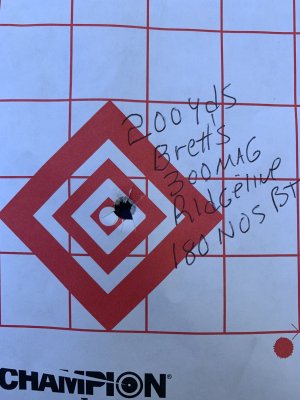
The second target is from my Hankins Muzzleloader and it is also at 200 yards. I will need this gun in about 9 days for our early 2 day ML season. I was likewise happy with the shot and put the gun back in the case.
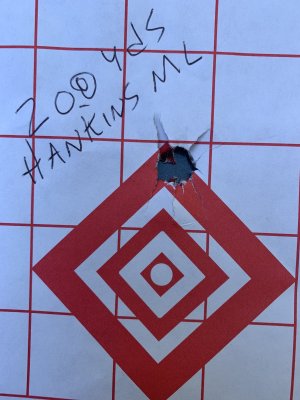
Third gun is my 300 Mag. I discovered a couple of years back that my gun would shoot my son's handloads extremely tight. This year I went ahead and sighted my gun in using his shells, so now we don't have to worry about getting shells messed up. A couple of years ago when I first tried this, I put 4 in the same hole at 100 yards. Today I just shot twice and both almost went in the same hole. First target is the 4 shot group and second is the 2 shot group.
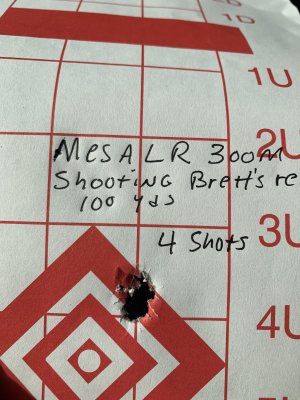

My dad got the urge a few years ago to have a custom 30-06 Ackley Improved built. The gun has a Shilen Barrel, a Sako Action and a HS Precision stock. He used the gun one time to go out west and kill a mule deer, and it has been setting in a safe for about 20 years. His days of shooting big guns like this are over so he gave me the gun. I tried it out a little today. The first shot on an oily barrel went a little high, but still printed a 4 shot group just barely less than an inch at 100 yds. The following 3 shots on a dirty barrel went into .68 inches at 100. I clicked it up a couple of clicks and left it. Later this winter when the weather is colder, I will fool with this gun a little more.
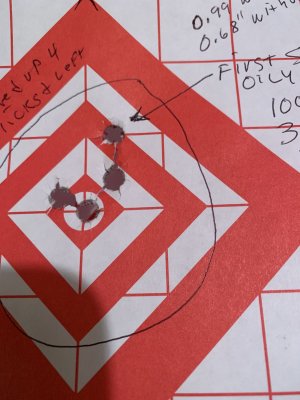
The last gun I tried is a 25-06 Remington Sendero. The gun typically shoots between 1/2 and 3/4 of an inch at 100 yds, and that is what it did today. The group center was just a hair left, so I did adjust a couple of clicks.
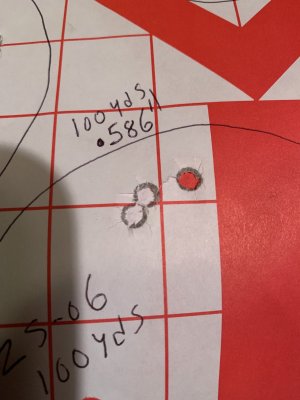
It got too hot to be shooting, so I quit after this. My main goals today was to check my Muzzleloader and sight my 300 Mag in to shoot the same shells as my son - and I got that done.
First gun is my son's 300 Mag Christensen Arms Ridgeline. It is shooting a full throttle handload I worked out with a 180 Nosler Ballistic Tip bullet. I shot it one time at 200 yards and put it back in the case.

The second target is from my Hankins Muzzleloader and it is also at 200 yards. I will need this gun in about 9 days for our early 2 day ML season. I was likewise happy with the shot and put the gun back in the case.

Third gun is my 300 Mag. I discovered a couple of years back that my gun would shoot my son's handloads extremely tight. This year I went ahead and sighted my gun in using his shells, so now we don't have to worry about getting shells messed up. A couple of years ago when I first tried this, I put 4 in the same hole at 100 yards. Today I just shot twice and both almost went in the same hole. First target is the 4 shot group and second is the 2 shot group.


My dad got the urge a few years ago to have a custom 30-06 Ackley Improved built. The gun has a Shilen Barrel, a Sako Action and a HS Precision stock. He used the gun one time to go out west and kill a mule deer, and it has been setting in a safe for about 20 years. His days of shooting big guns like this are over so he gave me the gun. I tried it out a little today. The first shot on an oily barrel went a little high, but still printed a 4 shot group just barely less than an inch at 100 yds. The following 3 shots on a dirty barrel went into .68 inches at 100. I clicked it up a couple of clicks and left it. Later this winter when the weather is colder, I will fool with this gun a little more.

The last gun I tried is a 25-06 Remington Sendero. The gun typically shoots between 1/2 and 3/4 of an inch at 100 yds, and that is what it did today. The group center was just a hair left, so I did adjust a couple of clicks.

It got too hot to be shooting, so I quit after this. My main goals today was to check my Muzzleloader and sight my 300 Mag in to shoot the same shells as my son - and I got that done.
